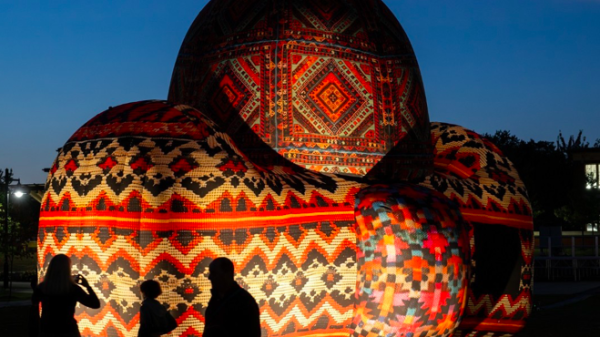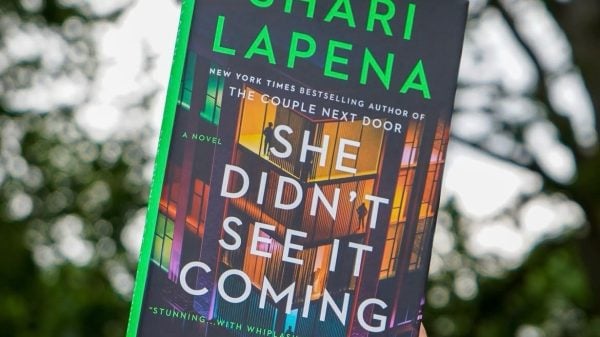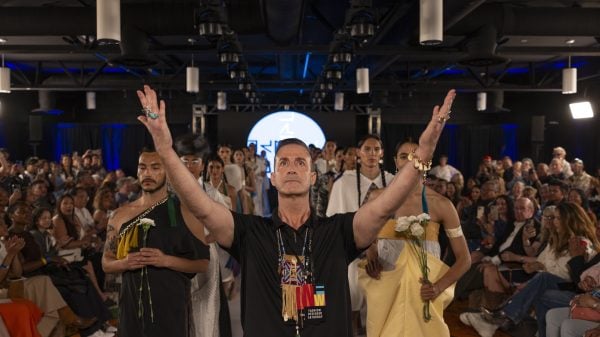The legacy of the quilt lives on, in Rebecca Caulford‘s studio that is. Inside her “Designhive“, original creations are born under the brand name that Caulford lovingly dubbed in honour of the honeybee, Honeybea.
Since opening her business nearly 20 years ago, Caulford has spent a great deal of her time scouring thrift and secondhand stores for fabrics and heirloom textiles. Her love of quilted clothing and reworking old pieces comes from the thrill of finding fabrics that have a story to tell. By salvaging them, their stories continue.
“When I see an old, raggedy quilt or afghan so deteriorated that it is about to be lost forever, I feel so emotionally compelled to keep it alive,” she told STYLE Canada’s Mursal Rahman.
Caulford’s admiration for the quilting process is also based on the fact that it provides a more sustainable way of clothes making.
“That’s the beauty of circular fashion… It’s an endless cycle and will always make someone else’s day,” Caulford said.
We couldn’t agree more. So, in honour of our editorial theme for the month being ‘sustainability’, we spoke with Caulford all about her brand, business and creative process. Scroll to read the exclusive interview below.

Founder of Honeybea Rebecca Caulford
SC: Why did you call your clothing brand Honeybea?
RC: I love the totally instinctual and unbreakable drive of the quiet little honeybee, that just gets out there and gets it done for the greater good, happily among the flowers. My oldest friends and family have always called me Bea, and honestly, when I named my company Honeybea so long ago I really didn’t think this business would grow to be what it is today. I’ve always been totally in the moment. No business plan either, just a love of making and the culture, so here we are.
SC: When did your love of fashion begin?
RC: There are loads of pictures of me as a kid dressed to the nines in my mom’s slips and high heels, but my love of fashion really started when I was old enough to hit Kensington Market on the streetcar with my friends back in the early 90s.
SC: What inspired you to create quilted clothing?
RC: I believe there is love in old quilts that bonds us. That good-hearted kind of love steeped in a shared feeling of nostalgia that makes us feel safe and comforted. I believe that love is contagious and that by making things out of old quilts I could spread love and make the world a kinder place. It might sound too easy, but I’ve seen it time and time again. Clothing made of something with a soul has the power to disarm strangers. The warmth and friendliness clothing is filled with brings out the best in us and prompts us to be kind in return. That in itself inspires and motivates me every day.
SC: What do you love about reworking old clothing?
RC: I love the chain reaction. The thrill of finding a treasure by the grace of the universe before it is lost forever, feeling all the good energy it brings with it, pouring mine into the mix and sending it back out into the world again to find it a soulmate and begin a brand new path. I love that reworked clothing has a story to tell and that by salvaging it we can let it keep writing more. Can you imagine that book, started so long ago??

SC: Where do you find your fabrics and heirloom textiles?
RC: All over! Since starting my little business almost 20 years ago I have spent a great deal of my life scouring thrift stores (a.k.a heaven) and secondhand clothing facilities where I literally pick each material one precious piece at a time. But since COVID and the numerous lockdowns, the loss of those resources has prompted me to look elsewhere.
When the new year started I was worried about how we would continue with all the shops closed so I casually posted in my neighbourhood Facebook group seeing if anyone had any old quilts they might want to part with. The response blew me away! Such kind neighbours, I never knew I had, offering me everything from well wishes to a few donated quilts. They were thrilled to see their quilts given new life, to serious gold mines through antique textile dealers… It was life-changing in so many ways and has infused my work and New Year with a whole new sense of love and gratitude.
SC: What are you looking for when you are thrifting or looking for fabrics/pieces?
RC: As a designer, I know what I like so at first I’m literally scanning racks a mile a minute with my eyes and a sixth sense for my favourite colours, patterns and textures in clothing and fabrics. Then I do a few more in-depth laps to look a little deeper for the palettes and objects that may expand my creative horizons. In terms of specifics, I’m always looking for textiles, vintage clogs, a little something for my kids and a good, cozy mug.
SC: Can you tell me about the design process behind your pieces?
RC: My work has always been inspired by rescuing the most damaged heirloom textiles of all and preserving the love and wisdom that rests deep beneath the surface. When I see an old, raggedy quilt or afghan so deteriorated that it is about to be lost forever, I feel so emotionally compelled to keep it alive. That mission and passion have lead me to innovate a process of patch-working my garments together, by salvaging dozens of small pieces to create enough material to make one coat, for example.
In the end, it is the combinations I choose to put together that are my own unique art form and offering to the world. Each piece I make is like a painting, filled not just with the colours and textures that make my heart sing in the process, but with the union of the many hands and hearts that worked on each textile long ago. It’s a very powerful process, and I really think others can feel it too.

A knitted Honeybea creation
SC: How much work goes into making a quilted piece and an heirloom knit?
RC: It really depends on a few things. All of my materials are found in a completely unpredictable way so I never know what I’m going to get or what other materials I’ll have on hand that belong together in any one of my patchwork pieces. It can also take me years to cut something! These are precious commodities never to be had again so it’s hard to cut them, but if you really strip it down to me at my work table with a big stack of stunning materials that I have made my mind up to cut, it usually takes me a few hours to get them arranged. Sewing takes another few hours after that, and don’t forget the design process! All of our designs are original, we don’t use patterns that already exist. It’s a long, slow, beautiful process.
SC: What makes a quilted clothing piece so special?
RC: I think anyone in the whole wide world that would see a genuine heirloom quilt clothing piece, that was made truly with honour and integrity, would unanimously agree that it’s the love that makes a quilted garment so special. The history is of course fascinating beyond words too. Many of these quilts are over a century old, made with pieces of clothing and household rags that had worn out, stitched for years while life went on all around. But doesn’t that, in a nutshell, come down to the love? I think it does. Honeybea’s hashtag is #loveisall.
SC: How has COVID-19 impacted your business?
RC: To be honest, COVID has had a really positive impact on me as an artist, and therefore on Honeybea, which I realize is incredibly fortunate. In so many ways I needed the world to stop so I could regroup for a second. Running a fashion business is insanely scary and stressful a lot of the time, especially at the pace our world was demanding of us, and I was having a hard time staying in touch with the creative side of it.
While I would never undermine the horrific devastation this virus has had on humanity and the heartbreaking struggles of so many small businesses, I believe that COVID has offered us some critical lessons in how we operate moving forward and what we expect of each other, and ourselves. And for the record, I believe that we are going to see an amazing renaissance of true artist culture out there soon. I have the clearest visions of all the streets being dominated by the most meaningful, shapeshifting movement. I think there’s a lot of magic behind the scenes right now and I’m so excited to be apart of it.
SC: Can you provide some tips for someone who might want to rework one of their old pieces but has no idea how?
RC: Find the materials that speak to you and follow your heart. Other than that I’m sure there are loads of free patterns on Pinterest. Don’t be afraid to cut. Just think of all the little things you can do with the scraps!
SC: Since you have lots of experience thrifting, can you give some tips for someone who has never gone thrift shopping, but wants to start?
RC: Thrifting is such a thrill, so just have fun with it! I always wear clothing that is easy to try stuff on top of so I don’t have to bother with fitting room lineups. Find a quiet little corner of the shop at the end of your dig and sort through your treasures. Take chances on things and explore your style outside of your comfort zone. If there are things you don’t like after a few tries at home you can pass them along again. That’s the beauty of circular fashion… It’s an endless cycle and will always make someone else’s day.
SC: What has being a business owner taught you about yourself?
RC: That I am stronger than I ever knew, that I still must keep getting stronger every day, and that somehow I will. This is not for the faint of heart, but I wouldn’t change it for the world.
SC: What advice would you give other aspiring designers?
RC: Be original. Like, without thinking about it. Be completely you, and the rest will follow.
Check out Caulford’s original designs on www.honeybea.ca!









